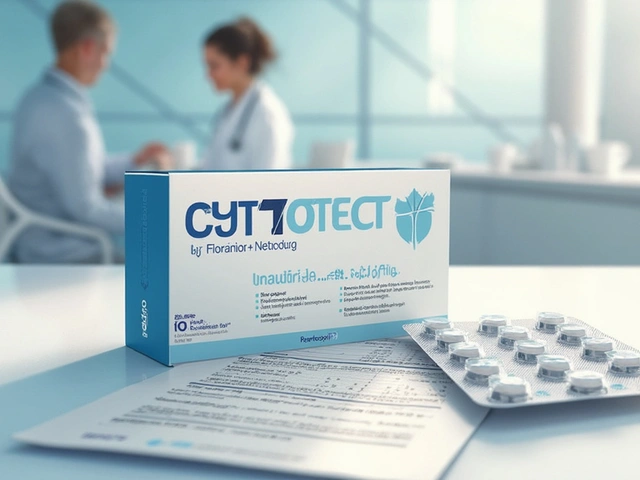Dealing with gout can feel like a constant battle against sudden, excruciating pain. While diet tweaks and anti‑inflammatory drugs help, the real game‑changer often lies in how we lower uric acid levels. That’s where Febuxostat a non‑purine xanthine oxidase inhibitor approved for chronic gout management steps in. This article walks you through the drug’s mechanism, when it’s the right choice, how it fits into a broader care plan, and what to watch out for. Expect practical tips, a side‑by‑side comparison with the classic therapy, and a quick FAQ to clear lingering doubts.
What Is Gout and Why Is Uric Acid Central?
Gout a form of inflammatory arthritis caused by monosodium urate crystal deposition in joints erupts when blood Uric Acid the end product of purine metabolism that, at high concentrations, precipitates as crystals climbs above its solubility threshold (about 6.8 mg/dL). The spikes can be triggered by high‑purine foods, alcohol, dehydration, or reduced renal clearance. Persistent hyperuricemia fuels more attacks, joint damage, and even kidney stones.
How Febuxostat Lowers Uric Acid
Unlike traditional drugs that mimic purines, febuxostat blocks the enzyme xanthine oxidase without being a substrate itself. This enzyme normally converts hypoxanthine to xanthine and then to uric acid. By inhibiting both steps, the drug reduces production at the source, keeping serum uric acid in the target range (≤ 6 mg/dL) for most patients.
When Do Doctors Choose Febuxostat Over Allopurinol?
Allopurinol remains first‑line for many, but several scenarios tip the scale toward febuxostat:
- Allopurinol intolerance (skin rash, hypersensitivity, or severe liver enzyme elevation).
- Renal impairment where allopurinol dose‑adjustment becomes cumbersome.
- Patients who have not reached uric acid target after maximised allopurinol.
Guidelines from the American College of Rheumatology (2023 update) list febuxostat as an alternative for those with contraindications to allopurinol or when dose escalation is limited.
Comparing Febuxostat and Allopurinol
| Feature | Febuxostat | Allopurinol |
|---|---|---|
| Mechanism | Selective xanthine oxidase inhibitor (non‑purine) | Purine analog, reversible xanthine oxidase inhibition |
| Typical Dose | 80 mg - 120 mg daily | 100 mg - 300 mg daily (adjusted for renal function) |
| Renal Adjustment | Not required in mild‑moderate CKD | Dose reduced for eGFR < 60 mL/min |
| Common Side Effects | Elevated liver enzymes, cardiovascular events (rare) | Skin rash, Stevens‑Johnson syndrome (rare), liver enzymes |
| Cost (US, 2024) | ≈ $150 / month | ≈ $30 / month (generic) |
The table shows why cost‑sensitive patients often start with allopurinol, while those needing a stronger uric‑lowering effect or who have renal concerns may jump to febuxostat.

Integrating Febuxostat into a Comprehensive Gout Care Plan
Medication alone won’t eradicate gout. A holistic approach blends drug therapy with lifestyle tweaks and monitoring. Here’s a practical roadmap:
- Baseline Assessment: Measure serum uric acid, renal function (eGFR), liver enzymes (ALT, AST), and cardiovascular risk profile.
- Start Low, Go Slow: Begin febuxostat at 40 mg daily for extreme sensitivity, then titrate to 80 mg after two weeks if uric acid remains > 6 mg/dL. Some clinicians jump straight to 80 mg in otherwise healthy adults.
- Adjunctive Anti‑inflammatories: During the first 3-6 months, gout flares may still occur as crystals dissolve. Use NSAIDs (e.g., naproxen 250 mg BID) or colchicine (0.6 mg once or twice daily) for breakthrough pain.
- Dietary Guidance: Limit high‑purine foods (red meat, organ meats, anchovies, sardines). Encourage low‑fat dairy, cherries, and adequate hydration (2-3 L water per day).
- Regular Monitoring: Check uric acid at 4‑week intervals until target achieved, then every 6 months. Re‑evaluate liver enzymes every 3 months the first year.
- Address Comorbidities: Manage hypertension, obesity, and diabetes. These conditions raise uric acid and increase flare frequency.
By syncing febuxostat with these steps, patients often see a 70‑80 % reduction in flare frequency within six months.
Potential Side Effects and Safety Concerns
Like any medication, febuxostat carries risks. The most frequently reported issues are mild and reversible:
- Elevated liver enzymes - check ALT/AST; typically normalizes after dose reduction.
- Gastro‑intestinal upset - nausea, abdominal pain; take with food.
- Rash - if it spreads or becomes severe, discontinue immediately.
More serious, though rare, concerns involve cardiovascular events (myocardial infarction, stroke). The CARES trial (2018) flagged a modest increase in heart‑related deaths compared with allopurinol, prompting clinicians to weigh benefits against cardiac risk, especially in patients with existing heart disease.
Drug interactions worth noting:
- Azathioprine and mercaptopurine - both metabolised by xanthine oxidase; febuxostat can increase their levels, leading to toxicity.
- Warfarin - some reports of altered INR; monitor anticoagulation closely.
When in doubt, involve a pharmacist to double‑check the full medication list.
Special Populations: What About Kids, Pregnant Women, and the Elderly?
Febuxostat is not approved for children under 18. For pregnant or breastfeeding women, the drug is usually avoided; data on teratogenicity are limited. In the elderly, renal function often declines, but febuxostat’s minimal renal dosing requirement makes it a viable option-provided liver function is intact and cardiovascular risk is monitored.

Real‑World Patient Story
John, a 58‑year‑old carpenter from Bristol, had lived with gout for a decade. He tried diet changes, NSAIDs, and even allopurinol 300 mg daily, but his uric acid lingered at 7.2 mg/dL and flares hit him monthly. After a referral to a rheumatologist, febuxostat 80 mg was introduced. Within six weeks, his serum uric acid fell to 5.4 mg/dL, and he reported only one minor flare in the following quarter. By coupling the drug with a low‑purine diet and daily cherry juice, John now enjoys pain‑free weekends and can work longer without interruption.
Key Takeaways
- Febuxostat is a potent, non‑purine xanthine oxidase inhibitor that effectively lowers uric acid, even in patients with mild‑moderate kidney disease.
- Ideal for allopurinol‑intolerant patients or those who need stronger uric‑lowering power.
- Start low, monitor liver enzymes, and watch for rare cardiovascular signals.
- Combine medication with diet, hydration, and anti‑inflammatory agents during the initial months.
- Regular labs and holistic management of comorbidities are essential for long‑term success.
Frequently Asked Questions
Can I take febuxostat with allopurinol?
No. Both drugs block the same enzyme, so combining them offers no extra benefit and increases the risk of side effects. If one fails, switch to the other under medical supervision.
How long does it take for febuxostat to reduce uric acid?
Serum uric acid usually drops within 2-4 weeks, reaching a stable plateau by 8-12 weeks if the dose is appropriate.
Is febuxostat safe for people with heart disease?
The CARES trial suggested a modest increase in cardiovascular events. Discuss personal risk with your doctor; low‑dose therapy and close monitoring may mitigate danger.
Do I need to stop febuxostat before surgery?
Typically, you can continue febuxostat through most surgeries. However, inform the surgical team; they might pause it if you’ll be on high‑dose NSAIDs post‑op to avoid bleeding risk.
Can diet alone control gout without medication?
Mild hyperuricemia can sometimes be managed with strict diet, weight loss, and hydration, but most patients with recurrent flares need a urate‑lowering drug like febuxostat or allopurinol.
By understanding how febuxostat works, who benefits most, and how to pair it with everyday choices, you can move from reactive flare‑treatment to proactive gout control. Talk to your rheumatologist or pharmacist to see if febuxostat fits your personalized care plan.









Joe Langner
October 26, 2025 AT 21:06Hey folks, reading through this guide feels like a breath of fresh air in the gout war – you know, the kind where every little win feels like a tiny victory over fate. It's great to see a drug that doesn't just mask the pain but actually tackles the root cause, letting us imagine a life less haunted by sudden flare‑ups. Remember, even the toughest battles are won one step at a time, and febuaxostat looks like a solid step forward. Keep the optimism alive, stay hydrated, and maybe add a cherry smoothie for extra morale. We're all in this together, so don't lose hope, even if the side‑effects sound a bit scary.
Ben Dover
November 5, 2025 AT 12:06Upon meticulous examination of the presented data, one discerns that febuxostat's pharmacodynamics render it a commendable alternative for patients contraindicated to allopurinol. The comparative table elucidates cost disparities, yet the clinical efficacy outweighs mere financial considerations. Moreover, the referenced CARES trial warrants vigilant appraisal of cardiovascular risk. Consequently, prescribing should be predicated upon a comprehensive risk‑benefit analysis rather than expedient cost‑saving.
Tony Stolfa
November 15, 2025 AT 03:06Man, if you’re still on allopurinol and choking on side‑effects, just switch to febuxostat already. Stop wasting time and get your uric acid down like a boss.
Joy Dua
November 24, 2025 AT 18:06In the grand tapestry of therapeutics, febuxostat emerges as a vivid thread interwoven with biochemical precision; it transcends mere symptom control and engages the very alchemy of uric acid synthesis. The elegance of a non‑purine inhibitor lies in its capacity to circumnavigate renal constraints while preserving hepatic harmony. Such paradoxical harmony beckons the discerning clinician to contemplate its place within a holistic regimen.
Holly Kress
December 4, 2025 AT 09:06I appreciate the thoroughness of this article and wanted to add a few practical tips for anyone starting febuxostat. First, schedule your baseline labs before the first dose and keep a copy for future reference. Second, set a reminder to take the medication with breakfast to minimise stomach upset. Third, track your gout attacks in a simple journal – noting triggers can be surprisingly revealing. Finally, remember that lifestyle changes complement the medication and often amplify its benefits.
Chris L
December 14, 2025 AT 00:06Great rundown! Staying positive while navigating medication changes can make a huge difference, so keep that hopeful mindset. If you notice any mild liver enzyme bump, a quick chat with your doctor usually resolves it without halting therapy. Don't forget to stay active – gentle walks help kidney function and overall wellbeing. Together we can turn gout from a dreaded guest into a manageable condition.